|
It's All About the
Pattern
by Bob Brooke
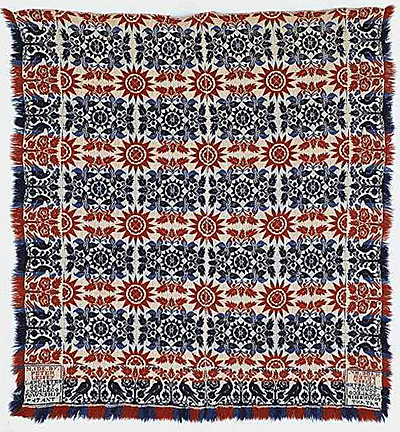 Today,
museum gift shops often display and sell woven coverlets. But back
in the early 19th century, they were a necessity to help keep people
warm as they slept by the cool heat of a steeped fire. Sometimes
called coverlids, they differed from a bedspread which extended to
the floor by only covering the top and sides of the bed. Today,
museum gift shops often display and sell woven coverlets. But back
in the early 19th century, they were a necessity to help keep people
warm as they slept by the cool heat of a steeped fire. Sometimes
called coverlids, they differed from a bedspread which extended to
the floor by only covering the top and sides of the bed.
The variety of coverlets that have been produced since then is
astonishing. And the patterns produced were like no other types of
weaving. Individuals wove one-of-a-kind coverlets as gifts for
family members or in preparation for housekeeping or to celebrate an
important event.
 Coverlets
originated in Europe. Early ones, woven on a four-harness type loom,
didn’t have complex patterns like those made in the mid 19th century
in the United States. The invention of the “Jacquard” loom
attachment made their unique designs possible. Coverlets
originated in Europe. Early ones, woven on a four-harness type loom,
didn’t have complex patterns like those made in the mid 19th century
in the United States. The invention of the “Jacquard” loom
attachment made their unique designs possible.
Household weavers, usually women, produced these decorative and warm
bed covers. They created simple but visually exciting geometric
overshot coverlets. The term overshot comes from the technique in
which horizontal or weft yarns skipped or overshot three or more
vertical or warp yards at a time. This resulted in a loosely woven
appearance. Most weavers used a narrow four-harness loom to weave
their coverlets, then sewed two halves together to form one large
enough to cover a bed.
They made many of their coverlets in vibrant colors, such as red and
blue, a popular color combination. They dyed the wool red with
madder root and blue by dyeing with indigo. Green was an uncommon
color. Synthetic dyes, however, weren’t available until after the
Civil War.
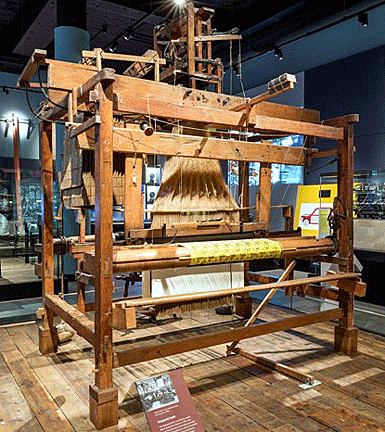 Complex,
figural designs were more difficult to produce alone on the same
loom. That changed in 1806 when Joseph Marie Jacquard of France
invented a mechanical attachment that could be attached to most
looms by professional male weavers. A series of punched cards guided
the raising and lowering of the warp threads to form complex designs
over a greater number of harnesses. Repeated motifs could be
endlessly varied and re-combined. Floral designs, birds, simple
buildings and stars were common, with a central section usually
framed by a border along the top, sides, and bottom. Many Jacquard
coverlet weavers "signed" and dated their textiles on the decorative
corner blocks at the bottom corners. Complex,
figural designs were more difficult to produce alone on the same
loom. That changed in 1806 when Joseph Marie Jacquard of France
invented a mechanical attachment that could be attached to most
looms by professional male weavers. A series of punched cards guided
the raising and lowering of the warp threads to form complex designs
over a greater number of harnesses. Repeated motifs could be
endlessly varied and re-combined. Floral designs, birds, simple
buildings and stars were common, with a central section usually
framed by a border along the top, sides, and bottom. Many Jacquard
coverlet weavers "signed" and dated their textiles on the decorative
corner blocks at the bottom corners.
Traveling weavers made 90 percent of the Jacquard coverlets produced
in New York, Pennsylvania, Ohio, and Indiana.
The Jacquard attachment first appeared in America in the early
1820s, probably when one of the many German, English and French hand
weavers brought it with them when they immigrated from their native
countries in Europe. These immigrant weavers tended to settle in
areas with populations of their own ethnic group and near sources of
good quality wool. Many brought some type of Jacquard attachment or
at least the experience to use one. Some even developed their own
devices based on Jacquard's idea and patented them in the U.S.
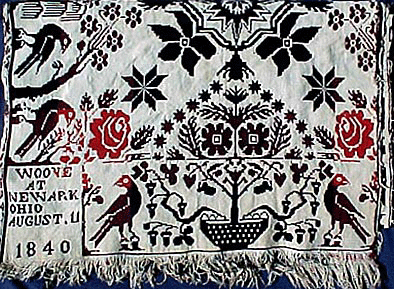 The
earliest American Jacquard coverlets appeared in New York and
Pennsylvania around the same time. As weavers saturated the market
in the Eastern states, and weaving became more mechanized and moved
into a factory setting, many weavers moved westward into Ohio and
Indiana, and eventually to Illinois, looking for new markets as well
as farmland. Raw wool and commercially spun yarns as well as natural
and synthetic dyestuffs needed for weaving could easily be obtained
throughout the state. The weavers settled in or near agrarian
communities among people of shared backgrounds and familiar with
folk motifs and designs used in coverlets, primarily those from
Germany, France and England. The weavers made lasting contributions
to the communities in which they settled, opening businesses and
promoting weaving; perhaps most importantly, they brought a touch of
color and technical design to an expanding 19th-century population
on the western frontier. The
earliest American Jacquard coverlets appeared in New York and
Pennsylvania around the same time. As weavers saturated the market
in the Eastern states, and weaving became more mechanized and moved
into a factory setting, many weavers moved westward into Ohio and
Indiana, and eventually to Illinois, looking for new markets as well
as farmland. Raw wool and commercially spun yarns as well as natural
and synthetic dyestuffs needed for weaving could easily be obtained
throughout the state. The weavers settled in or near agrarian
communities among people of shared backgrounds and familiar with
folk motifs and designs used in coverlets, primarily those from
Germany, France and England. The weavers made lasting contributions
to the communities in which they settled, opening businesses and
promoting weaving; perhaps most importantly, they brought a touch of
color and technical design to an expanding 19th-century population
on the western frontier.
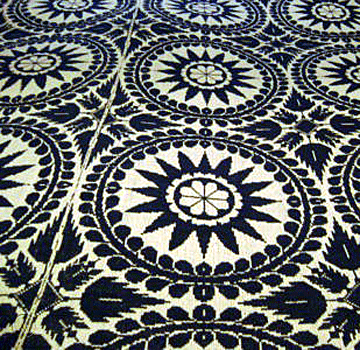 The
designs of most Illinois coverlets can be traced back to Ohio and
Pennsylvania coverlets. The center field patterns were either a
large, repeated symmetrical motif on two-piece ones or a centered
medallion on single-width coverlets. Floral motifs appeared most
frequently, in the Four Lilies and Sun-burst, Four Roses, Octagonal
Four Roses, Four Leaves and Four Acorns, and Four Bellflowers
patterns. Star and Sunburst designs were also common. The
designs of most Illinois coverlets can be traced back to Ohio and
Pennsylvania coverlets. The center field patterns were either a
large, repeated symmetrical motif on two-piece ones or a centered
medallion on single-width coverlets. Floral motifs appeared most
frequently, in the Four Lilies and Sun-burst, Four Roses, Octagonal
Four Roses, Four Leaves and Four Acorns, and Four Bellflowers
patterns. Star and Sunburst designs were also common.
Illinois represents the most western production area of these fancy
and figured coverlets in America. Only a very small number were
woven in Missouri, Iowa and Kansas. John Seewald in St. Clair County
near the Mississippi River and St. Louis, Missouri, wove the
earliest dated surviving coverlet from Illinois in 1841. The
majority of Illinois examples date from the 1850s with a number
woven by three weavers in the late 1860s and 1870s. The second
greatest concentration of coverlet weavers occurred in central
Illinois, centered around Peoria County, where six of the weavers
were active between 1846 and about 1870, producing 42 of 130 known
surviving coverlets.
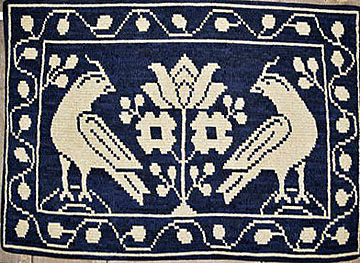 Illinois
Jacquard coverlets, like their Pennsylvania counterparts, had
borders along each side and the bottom. Popular traditional Germanic
motifs include the distelfink, or thistle finch, and Grapevine. A
corner block or name line identifies the weaver, his location, and
usually the year of production. Illinois
Jacquard coverlets, like their Pennsylvania counterparts, had
borders along each side and the bottom. Popular traditional Germanic
motifs include the distelfink, or thistle finch, and Grapevine. A
corner block or name line identifies the weaver, his location, and
usually the year of production.
Typically, weavers produced cotton coverlets for weddings and
births. Most young women made wedding or bride coverlets or blankets
for their hope chest. Starting around 1825, major towns had a
resident weaver whose job it was to make blankets and accept work on
commission. The weaver may have had an apprentice and the weaver’s
loom was the site of his/her business dealings. Coverlets were
double woven and produced with wool and imported indigo blue and
madder red or brown dyes. A traditional early 19th-century woven
coverlet would cost between $5 and $15.
These woven items were often made of cotton and wool, and in many
instances people would bring their request for a coverlet to a local
weaver to be constructed. Coverlets were much more commonplace than
quilts from about 1823 to the end of the Civil War in 1865.
In America, the practice of making coverlets using Jacquard looms
began to fade during the fourth quarter of the 19th century. The
import of cheaper materials into the U.S. became a difficult hurdle
for weavers to overcome.
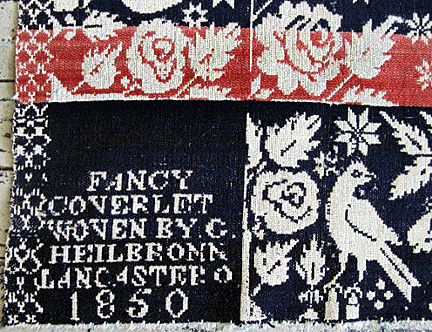 Though
few Jacquard looms still exist today, one family in Red Lion,
Pennsylvania, still uses refurbished Jacquard looms to turn out a
variety of coverlets and other woven articles and rugs from their
business,
Family Heirloom Weavers. Though
few Jacquard looms still exist today, one family in Red Lion,
Pennsylvania, still uses refurbished Jacquard looms to turn out a
variety of coverlets and other woven articles and rugs from their
business,
Family Heirloom Weavers.
Some of the best ways to identify the origin of a Jacquard coverlet
is to just read the name, location, and date that the coverlet was
made directly on the piece itself. The evidence of blood, typically
from a horse or a wounded soldier, helps to authenticate the age of
many of these woven blankets. Jacquard coverlets were used by
families when taking long journeys on a horse drawn carriage or
stage coaches and on the battlefield or in private homes. The market
value for high quality Jacquard coverlets made in America range from
the several hundreds of dollars to the several thousands of dollars
depending on pattern, intricate details, provenance or family
origin, and condition.
<
Back to More Antique Spotlights
Next Article >
|
